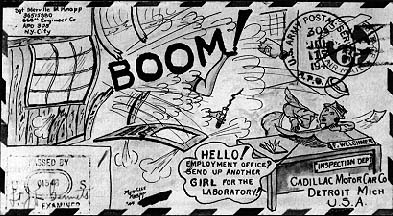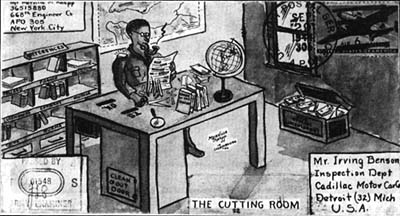 WORK
BY ROBERT KEATTS
WORK
BY ROBERT KEATTS
 WORK
BY ROBERT KEATTS
WORK
BY ROBERT KEATTS
During World War II, many Americans had to leave their jobs for military service; others stayed behind in the States. One who went and one who stayed kept in touch. They were Sergeant Merville M. Knapp, with the 668th Engineer Topographical Company Corps, and Irving E.R. Benson, with the inspection department of Cadillac Motor Car Division, where M-24 tanks were being built. Their letters relay interesting stories, concerns, and victories; of special interest are several envelopes from this correspondence which offer other stories - in pictures.
In the fall of 1942, Knapp shipped out to Great Britain. He was one of ten men assigned to construct scale models of the French coastline. These models were used to plan the D-Day invasion.
By January 14, 1944, more than 4,000 square miles of France had been recreated on relief models that not only included the terrain, but also buildings, roads, railroads, trees, and whatever else was deemed essential. The areas of France selected as landing sites were enlarged as separate models. Each model was made up of several twenty-five-inch-square panels.
By May 1, 1944, the team of ten men had completed its initial mission and had to wait for the invasion before assuming new map-making projects.
After the invasion, Knapp turned some of his artistic ability to envelopes, drawing scenes on them that depicted daily events. The actual number of envelopes he produced and sent to friends is unknown, but I know of five that still exist.
The first dates back to July when Knapp was still in France.
 |
Knapp used colored pencils to create this self-portrait, which pictures him smoking a cigarette and readingThe Cadillac War Craftsman.Obviously Knapp was not a member of a combat unit.
Another cover is referenced in a letter dated September 27, 1944.
 |
Knapp wrote: "A remark in your letter set me wondering. In referring to my cartoon to Frank about the explosion, you conveyed the idea to me that something like that happened. If it did, I assure you I knew nothing of it."
By September 29, Knapp was in Luxembourg and targeting a lieutenant for mail censorship.
 |
The artwork is done in watercolor and ink. The title, "THE CUTTING ROOM," is pasted over the original, "THE CENSOR." The significance of the number "22" below that title is not known.
By December, Knapp was in Belgium. His letter explains the cartoon.
 |
I'm afraid that the one I had ready for you wouldn't appeal to you as being very funny at present, so I've re-addressed one that I had ready for my father. . . . As to the cartoon: you might say that it is in the form of an examination, for if you fellows catch on to it, you have a reasonably high "IQ," but if the girls catch on, well - they have minds that are not exactly pure.
Knapp was still "somewhere in Belgium" on January 31, 1945.
 |
In the next letter, dated April 5, 1945, APO 137, Knapp notes, "I'm enclosing an envelope full of stamps that I found in one of the rooms I occupied." Knapp goes on with instructions to "Pick out what you like or all of them . . . and then on down to the Philatelist.Yes I know what that is. I received a letter from him once."
Sometime between April 5 and May 23, 1945, censorship ceased; a letter mailed May 23 from APO 137 has no censorship stamp on it.
Knapp, now in Plzen, Czechoslovakia, writes that he is pleased that someone in the family liked the stamps and would send more.
Knapp's next letter, postmarked June 13, notes, "Collection of stamps purchased in Pilsen Czecho." Evidently Knapp saw a window display of stamps that were rather attractive. Knapp states:
Some of the stamps are known as Protektorate stamps and are of Bohemia and Moravia which as you know comprise a part of Czechoslovakia. In fact Plzen is in Bohemia and therefore to cancel these stamps with the Plzen stamp, makes them more valuable. So I sent these two sheets of stamps to a friend with whom I have a connection in the Plzen post office. He kindly canceled them with the proper dates, by setting his machine back, in order that the cancellations would conform with the dates of issue of the stamps. Just between you and me, this is slightly irregular but these people will do most anything for us, for they claim that we saved their lives by arriving at the time we did. These cancellations make the stamps very valuable and I'm sure that your daughter will understand, if she is an ardent collector, and it will make a nice addition to her collection.
Today, the whereabouts of those stamps are unknown to family members.
The Author
Robert Keatts is an agricultural field specialist. When he is not farming, he works on his collection of postal memorabilia and history, an ongoing activity since 1957.